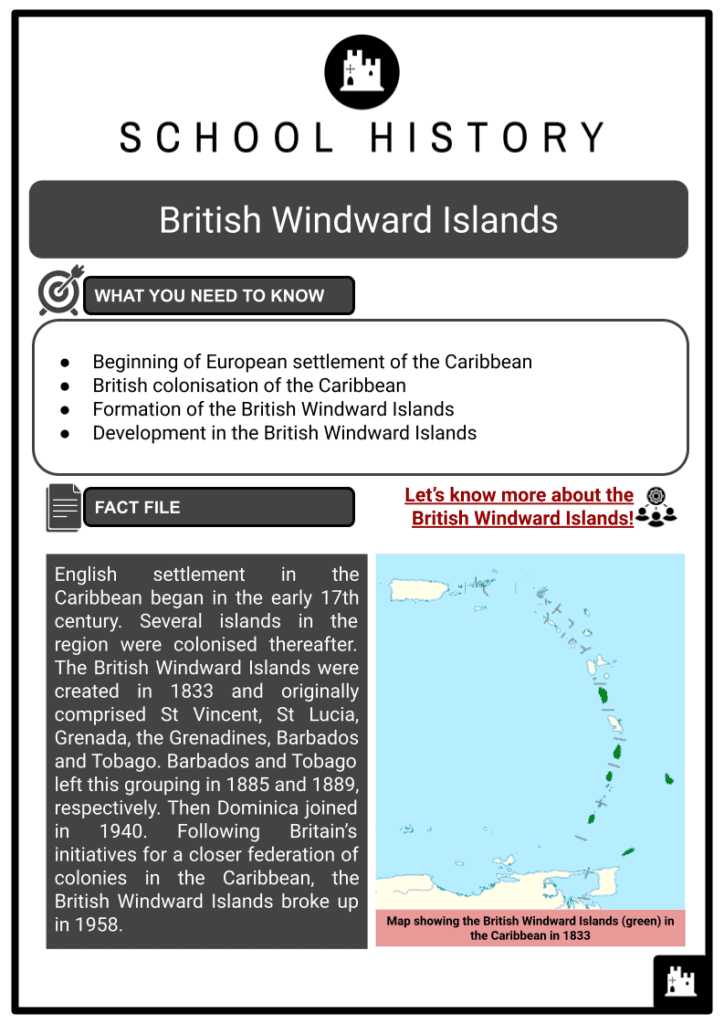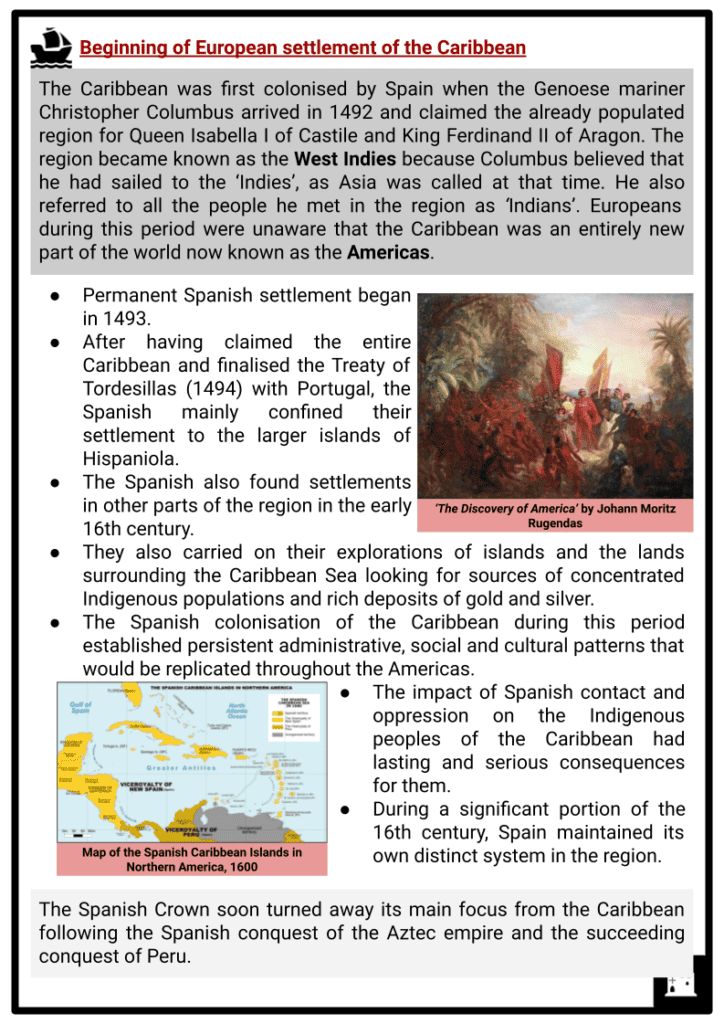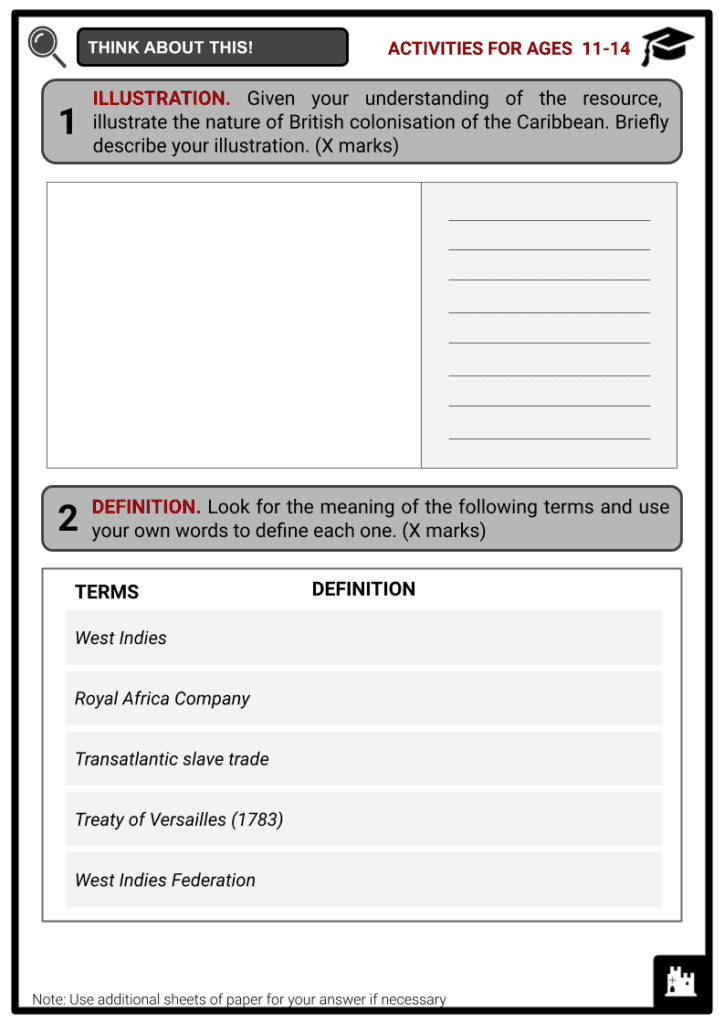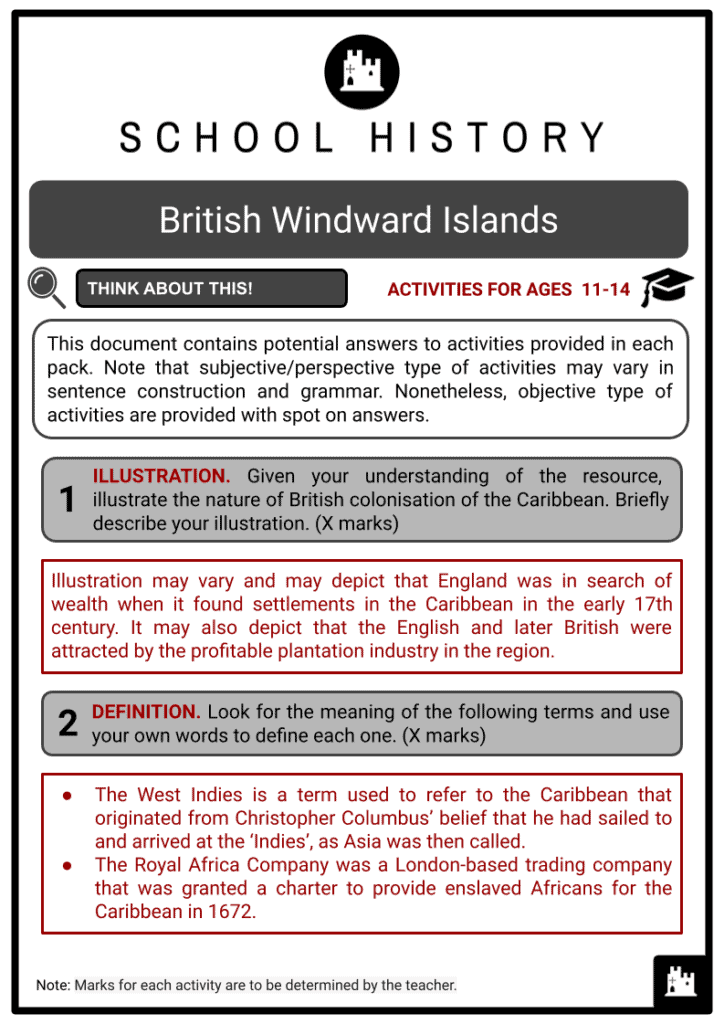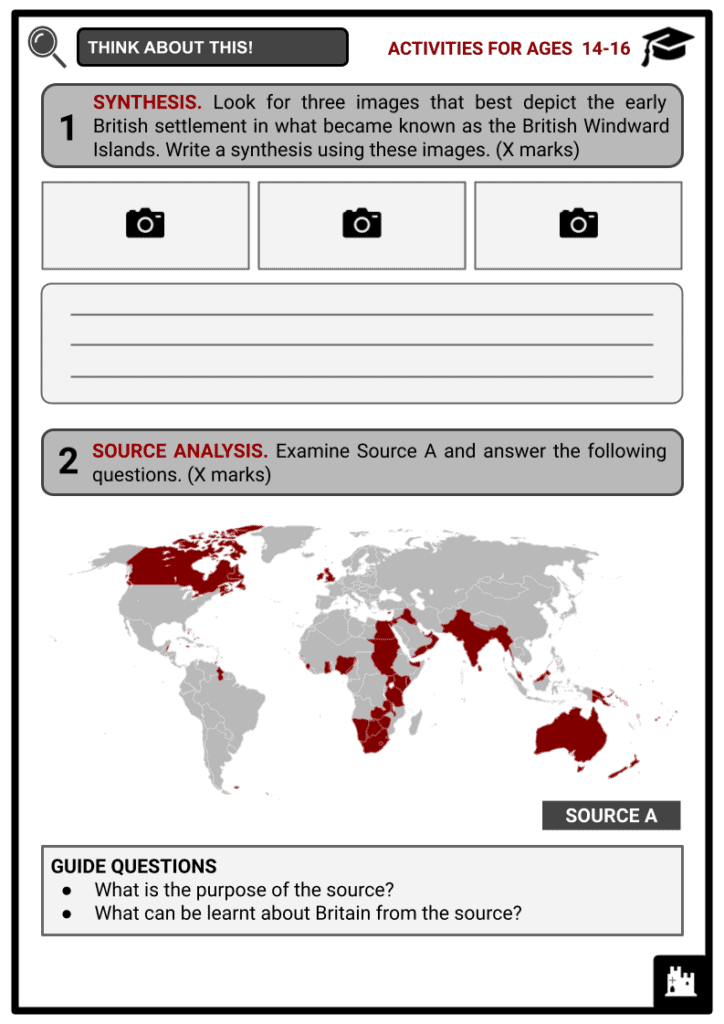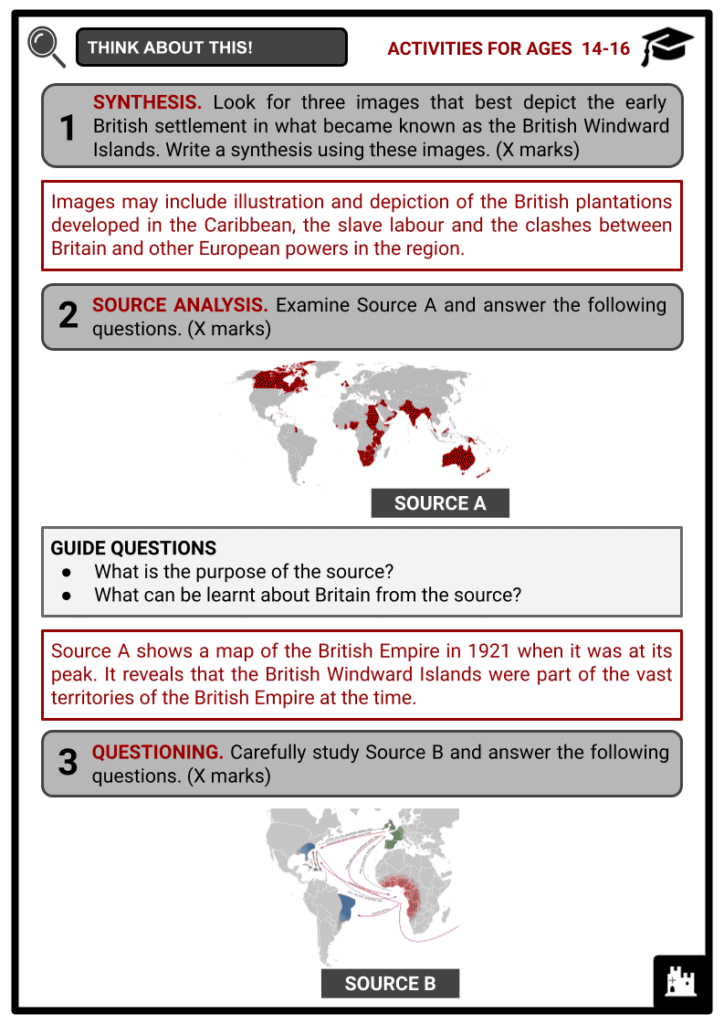British Windward Islands Worksheets
Do you want to save dozens of hours in time? Get your evenings and weekends back? Be able to teach about British Windward Islands to your students?
Our worksheet bundle includes a fact file and printable worksheets and student activities. Perfect for both the classroom and homeschooling!
Summary
- Beginning of European settlement of the Caribbean
- British colonisation of the Caribbean
- Formation of the British Windward Islands
- Development in the British Windward Islands
Key Facts And Information
Let’s know more about the British Windward Islands!
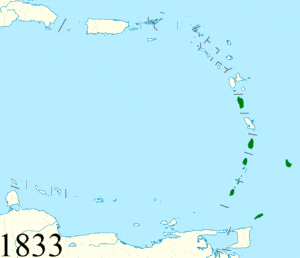
English settlement in the Caribbean began in the early 17th century. Several islands in the region were colonised thereafter. The British Windward Islands were created in 1833 and originally comprised St Vincent, St Lucia, Grenada, the Grenadines, Barbados and Tobago. Barbados and Tobago left this grouping in 1885 and 1889, respectively. Then Dominica joined in 1940. Following Britain’s initiatives for a closer federation of colonies in the Caribbean, the British Windward Islands broke up in 1958.
Beginning of European settlement of the Caribbean
- The Caribbean was first colonised by Spain when the Genoese mariner Christopher Columbus arrived in 1492 and claimed the already populated region for Queen Isabella I of Castile and King Ferdinand II of Aragon. The region became known as the West Indies because Columbus believed that he had sailed to the ‘Indies’, as Asia was called at that time. He also referred to all the people he met in the region as ‘Indians’. Europeans during this period were unaware that the Caribbean was an entirely new part of the world now known as the Americas.
- Permanent Spanish settlement began in 1493.
- After having claimed the entire Caribbean and finalised the Treaty of Tordesillas (1494) with Portugal, the Spanish mainly confined their settlement to the larger islands of Hispaniola.
- The Spanish also found settlements in other parts of the region in the early 16th century.
- They also carried on their explorations of islands and the lands surrounding the Caribbean Sea looking for sources of concentrated Indigenous populations and rich deposits of gold and silver.
- The Spanish colonisation of the Caribbean during this period established persistent administrative, social and cultural patterns that would be replicated throughout the Americas.
- The impact of Spanish contact and oppression on the Indigenous peoples of the Caribbean had lasting and serious consequences for them.
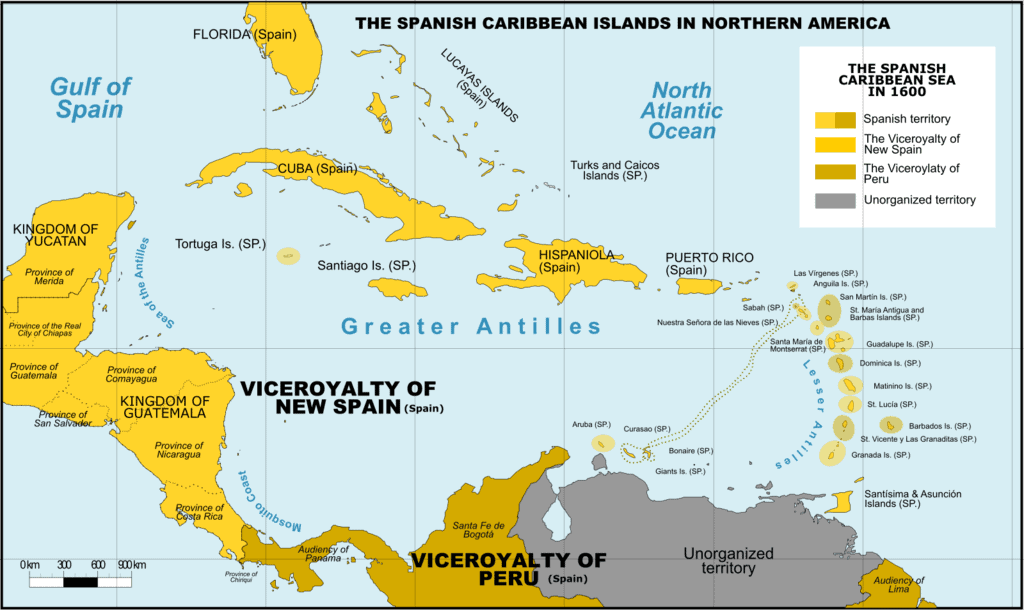
Map of the Spanish Caribbean Islands in Northern America, 1600 - During a significant portion of the 16th century, Spain maintained its own distinct system in the region.
- The Spanish Crown soon turned away its main focus from the Caribbean following the Spanish conquest of the Aztec empire and the succeeding conquest of Peru.
British colonisation of the Caribbean
- Spain and Portugal practically held a monopoly over the Caribbean islands and South America. The early Spanish transatlantic voyages paved the way for further European exploration of the American continent. It was in the early 17th century that other European powers in search of wealth, such as England and France, established settlements in the Caribbean. England had shown interest in the region in the preceding century.
- In 1562, the English admiral and privateer John Hawkins attacked Portuguese merchant ships and stole 300 enslaved people who he sold illegally in the Spanish Caribbean. At the time, indentured servants were being replaced by enslaved Africans. Many privateers made their fortunes through smuggling. Hawkins made two other voyages to take advantage of the lucrative slave trade in the Caribbean in 1564–65 and 1567–69.
- Hawkins was influential in encouraging others, including Francis Drake, to break Spain’s monopoly of trade in the Caribbean. Drake assaulted several Spanish settlements with the capture of the Spanish Silver Train at Nombre de Dios in March 1573, his most notable Caribbean exploit.
- The climate of Britain meant there were many products that could not be locally produced, including sugar and tobacco. The Caribbean was the perfect environment to grow these cash crops.
- The Caribbean islands offered European powers without colonies in the Americas the possibilities to develop sugar cane plantations based on the Spanish model, using enslaved African labourers. Additionally, the islands could also be used as bases for trade and piracy. English settlement in the Caribbean began with St Kitts in 1623, which became a base for further colonisation of the region including Barbados, Montserrat, Antigua and Nevis.
- In 1625, a few English colonists were sent to Barbados with the first settlement in the island beginning in 1627. The settlement was set up as a proprietary colony. The first settlers on the island included poor English people who worked as indentured labourers. Soon, hundreds of English people sailed there to make their fortunes in agriculture.
- In the 1640s, many freed indentured labourers left for the Americas as sugar cane plantations required large plots of land and expensive equipment that they were unable to afford.
- In 1655, the English had taken an interest in Jamaica and successfully overpowered the Spanish there. A significant number of Irish people who were mostly political prisoners of war were brought to the island as indentured labourers and soldiers. In the early 1670s, enslaved Africans formed the majority of the population as they were transported there to provide labour to the sugar cane plantations of the English.
- In 1672, the London-based Royal Africa Company was granted a charter to provide enslaved Africans for the Caribbean. Consequently, around 100,000 Africans were forced into slavery in the region between 1672 and 1689. The Company lost control of the transatlantic slave trade in 1689, enabling Bristol and Liverpool merchants to start participating in the trade.
- Between the 17th and 18th centuries, British colonisation in the Caribbean became linked to sugar cane plantations using slave labour imported from West Africa. Thousands of jobs were created in Britain by importing raw materials and exporting manufactured goods to supply to slave traders and the colonies. The wider British economy also improved, including financial, commercial, legal and insurance businesses related to the slave trade. While the slave trade brought huge profits and wealth for both Britain and the Caribbean, it had enduring and damaging effects on the Caribbean economies and, more importantly, on the Indigenous peoples of the Caribbean islands.
Formation of the British Windward Islands
- The Windward Islands refer to the Caribbean islands comprising the southern arc of the Lesser Antilles. They derive their name from their geography in relation to the dominant trade wind. The start of British settlement on these islands varied. The British Windward Islands were established in 1833 and originally consisted of the islands of St Vincent, St Lucia, Grenada, the Grenadines, Barbados and Tobago. Dominica joined this British administrative grouping in 1940.
Early British settlement on each island prior to the formation of the administrative grouping
St Vincent
- St Vincent was discovered by Columbus but had been largely ignored by the Spanish.
- In 1627, the English laid claim to the island but the French were the first European settlers there.
- It was ceded to Britain by the Treaty of Paris (1763). Between 1769 and 1773, the British engaged in a conflict, known as the First Carib War, with the Indigenous peoples in the territory. This resulted in a stalemate and a disappointing peace agreement.
- During the American War of Independence, St Vincent was captured in 1779 by France but was returned to Britain by the Treaty of Versailles (1783).
- The Second Carib War broke out in 1795 and the conflict between the British and the Indigenous peoples finally concluded in 1797 following a major British military expedition.
- As a result, many Indigenous peoples were deported to other neighbouring islands.
- Opposition from the Indigenous peoples was crushed and peace followed thereafter.
- The British used slave labour for the plantations of sugar, coffee, tobacco, cotton, cocoa and indigo in the territory. The island’s economy improved considerably.
St Lucia
- The first attempt to settle St Lucia was made by a group of English colonists in 1605 who were driven away by the Indigenous peoples in the same year.
- In 1635, France colonised the island.
- Between the 17th and the early 19th centuries, there had been attempts by England, later Britain, to seize St Lucia from France.
- In fact, St Lucia was the subject of numerous possession changes between the British and the French as several wars were fought, especially after the sugar industry developed in 1763.
- It also became a neutral territory a dozen times.
- However, the French settlements continued on the island, which became a de facto French colony.
- It was restored to the British in 1803 and formally ceded to Britain in 1814 with a predominantly French population.
Grenada
- In 1609, an English expedition first attempted to settle in Grenada. However, the colonists were attacked by the Indigenous peoples and the settlement was practically destroyed.
- The 17th century saw the French conquest and settlement of the island.
- Britain and France fought over control of the island in the 18th century.
- In 1783, the Treaty of Versailles ultimately led to British control of Grenada.
- Between 1795 and 1796, a revolt against British rule headed mainly by free mixed-race French speakers occurred on the island. The rebels were defeated by the British.
- The sugar industry in Grenada proved to be profitable in the early 19th century.
The Grenadines
- The Grenadines is a chain of small islands that lie on a line between St Vincent and Grenada.
- It was claimed by the French in 1664 as extensions of their holding of Grenada.
- As various European conflicts spilled over into the Caribbean, the Grenadines changed ownership often from the 17th to the 19th centuries, similar to several other Caribbean islands.
- In 1791, its islands were divided between Grenada and St Vincent for efficient administration in order to ensure their defence in time of conflicts, with St Vincent holding administrative control over the northerly territories and Grenada over the southerly territories.
- The islands of the Grenadines were consequently ruled by the British when St Vincent and Grenada were ceded to Britain.
Barbados
- The first English settlement in Barbados started in 1627 and was initially set up as a proprietary colony.
- Barbados was an English and later a British colony until the 19th century.
- In the 1640s, sugar cane cultivation began on the island. In 1645, around 5,500 enslaved Africans worked on these plantations.
- By the late 1660s, 80% of Barbados was sugar plantations as demand for sugar had grown dramatically in Britain for adding to tea, coffee and chocolate.
- A number of Black slave codes were imposed in the late 17th century that highlighted disparate treatment between Africans, and the white labourers and ruling planter class.
- This led to many unsuccessful slave rebellion attempts.
- The number of enslaved people grew to 42,000 in 1698.
- By 1710, 80% of the population on the island were enslaved.
Tobago
- In 1637, the English settlers from Barbados attempted to organise a colony in Tobago. However, an attack from the Indigenous peoples prevented the settlement.
- Further attempts at settlement were pursued by the English until 1646 but they all failed as several onslaughts by the Indigenous peoples made colonisation difficult.
- The island was left in the hands of its Indigenous population as several European colonists claimed the territory.
- A plantation economy was rapidly founded by Britain on the island following the end of Tobago’s neutral status in 1763.
- The island repeatedly alternated between France and Britain until the latter finally recaptured it in 1803.
Dominica
- Dominica became a British possession as accorded by the Treaty of Paris.
- French invasions of the island were launched between 1778 and 1805 but British control persisted.
- Britain set up a small colony in 1805 on the island and before long, sugar plantations were also established.
- After the abolition of slavery in 1834, Dominica became the sole British Caribbean colony to have a Black-led legislature in the 19th century, which was opposed by the wealthy British planter class.
- In 1871, it became part of the British Leeward Islands.
- In 1833, the British possessions in the Windward Islands were merged administratively as the British Windward Islands. The British Windward Islands were not considered a single colony, rather a coalition of separate colonies with a common governor-in-chief. Furthermore, each island maintained its own institutions. The seat of government was Barbados. While the administrative grouping had a common audit system, it did not have a common legislature, laws, revenue or tariff.
Development in the British Windward Islands
- The British Windward Islands joined together to maintain public institutions of general utility. The majority of the islands depended on the plantation economy. Although there were British attempts at a closer union, this grew unpopular as individual islands opposed it.
- In 1834, slavery was abolished in the British Empire. The enslaved people in the British Windward Islands were emancipated after a few years. This resulted in the eventual disintegration of the plantation system. Many of the affected planters and their families soon left the islands.
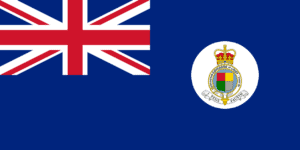
Flag of the British Windward Islands - Due to the labour shortages on the plantations on some islands, foreign labourers from Portugal and India were indentured beginning in the 1840s.
- From 1875 to 1876, Sir John Pope Hennessy was appointed Governor-in-Chief of the Windward Islands with primary authority over Barbados. He was tasked to organise a closer, formal federation of Barbados and the other islands, which met resistance from the ruling planting class, the press and a few prominent coloured people. Meanwhile, this plan was backed by labourers who believed that it would enable them to look for employment with higher wages or purchase their own plots of land elsewhere in the Windward Islands. However, the federation plan was abandoned due to fierce opposition and bloody riots.
- In 1885, Barbados left the British Windward Islands and returned to its former status of a completely separate colony. As a result, the seat of the governor of the British Windward Islands moved to St George’s on Grenada.
- Tobago’s economy suffered as a consequence of the collapse of its plantation industry. This led to the amalgamation of Tobago with Trinidad in 1889, hence the united colony of Trinidad and Tobago was formed. The cost of administering Tobago was transferred from the British Crown to the more thriving colony of Trinidad. This ended Tobago’s union with the British Windward Islands.
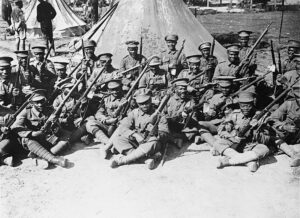
The British West Indies Regiment in northern France, September 1916 - When the First World War broke out in 1914, the British Windward Islands consisted of Grenada, the Grenadines, St Vincent and St Lucia. The islands sent officers and men to the British West Indies Regiment. Additionally, they made considerable contributions to various war charities. While they faced the prospect of food shortages, they were unequally impacted by the conflict. There emerged an upsurge of political consciousness throughout the Caribbean in the aftermath of the war.
- The islands participated once again in the war effort in the Second World War and sent men to join the Caribbean Regiment. In 1940, Dominica was transferred from the administration of the Leeward Islands to that of the British Windward Islands.
- Following the Second World War, Britain undertook several attempts at closer association among its colonies in the Caribbean in order to govern the region through a unified administration. The British wanted a federation of colonies to which they would grant independence as a single state. This resulted in the formation of the West Indies Federation.
- The British Windward Islands broke up in 1958 when the islands of St Lucia, St Vincent, Grenada, the Grenadines and Dominica decided to join the new West Indies Federation as separate provinces.
Image Sources
- https://upload.wikimedia.org/wikipedia/commons/1/1e/British_Windward_Islands.gif
- https://upload.wikimedia.org/wikipedia/commons/thumb/1/13/Spanish_Caribbean_Islands_in_the_American_Viceroyalties_1600.png/1024px-Spanish_Caribbean_Islands_in_the_American_Viceroyalties_1600.png
- https://upload.wikimedia.org/wikipedia/commons/thumb/1/1d/Flag_of_the_British_Windward_Islands_%281953-1960%29.svg/1280px-Flag_of_the_British_Windward_Islands_%281953-1960%29.svg.png
- https://upload.wikimedia.org/wikipedia/commons/thumb/4/43/British_West_Indies_Regiment_Q_001202.jpg/800px-British_West_Indies_Regiment_Q_001202.jpg
Frequently Asked Questions
- What are the British Windward Islands?
The British Windward Islands refer to a group of islands in the Caribbean Sea that are part of the Lesser Antilles. These islands were formerly part of the British West Indies and included Grenada, Saint Lucia, Saint Vincent and the Grenadines, and Dominica.
- What is the official language of the British Windward Islands?
English is the official language spoken in the British Windward Islands.
- Which Caribbean islands were British?
The Caribbean islands were once under British colonial rule at various points in time, including Jamaica, Barbados, Trinidad and Tobago, the Bahamas, Antigua and Barbuda, Saint Kitts and Nevis, Saint Lucia, Saint Vincent and the Grenadines, and Grenada.

